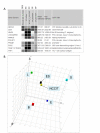Lineage relationship of prostate cancer cell types based on gene expression
- PMID: 21605402
- PMCID: PMC3113924
- DOI: 10.1186/1755-8794-4-46
Lineage relationship of prostate cancer cell types based on gene expression
Abstract
Background: Prostate tumor heterogeneity is a major factor in disease management. Heterogeneity could be due to multiple cancer cell types with distinct gene expression. Of clinical importance is the so-called cancer stem cell type. Cell type-specific transcriptomes are used to examine lineage relationship among cancer cell types and their expression similarity to normal cell types including stem/progenitor cells.
Methods: Transcriptomes were determined by Affymetrix DNA array analysis for the following cell types. Putative prostate progenitor cell populations were characterized and isolated by expression of the membrane transporter ABCG2. Stem cells were represented by embryonic stem and embryonal carcinoma cells. The cancer cell types were Gleason pattern 3 (glandular histomorphology) and pattern 4 (aglandular) sorted from primary tumors, cultured prostate cancer cell lines originally established from metastatic lesions, xenografts LuCaP 35 (adenocarcinoma phenotype) and LuCaP 49 (neuroendocrine/small cell carcinoma) grown in mice. No detectable gene expression differences were detected among serial passages of the LuCaP xenografts.
Results: Based on transcriptomes, the different cancer cell types could be clustered into a luminal-like grouping and a non-luminal-like (also not basal-like) grouping. The non-luminal-like types showed expression more similar to that of stem/progenitor cells than the luminal-like types. However, none showed expression of stem cell genes known to maintain stemness.
Conclusions: Non-luminal-like types are all representatives of aggressive disease, and this could be attributed to the similarity in overall gene expression to stem and progenitor cell types.
Figures






References
-
- Cunha GR, Alarid ET, Turner T, Donjacour AA, Boutin EL, Foster BA. Normal and abnormal development of the male urogenital tract. Role of androgens, mesenchymal-epithelial interactions, and growth factors. Journal of Andrology. 1992;13(6):465–475. - PubMed
Publication types
MeSH terms
Substances
Grants and funding
LinkOut - more resources
Full Text Sources
Medical

